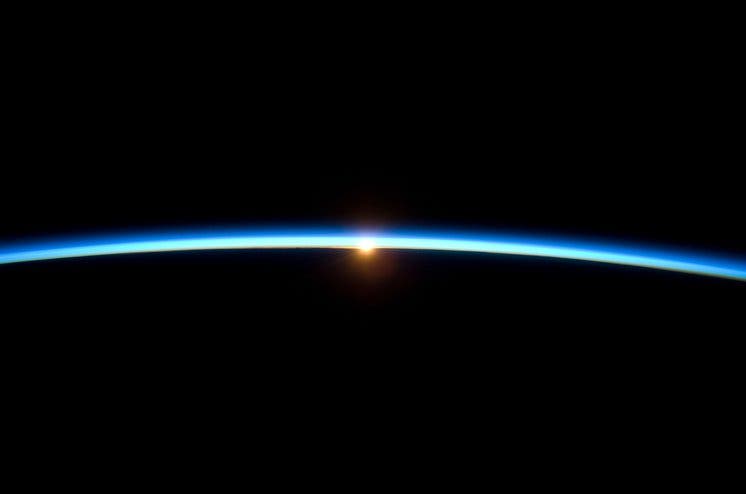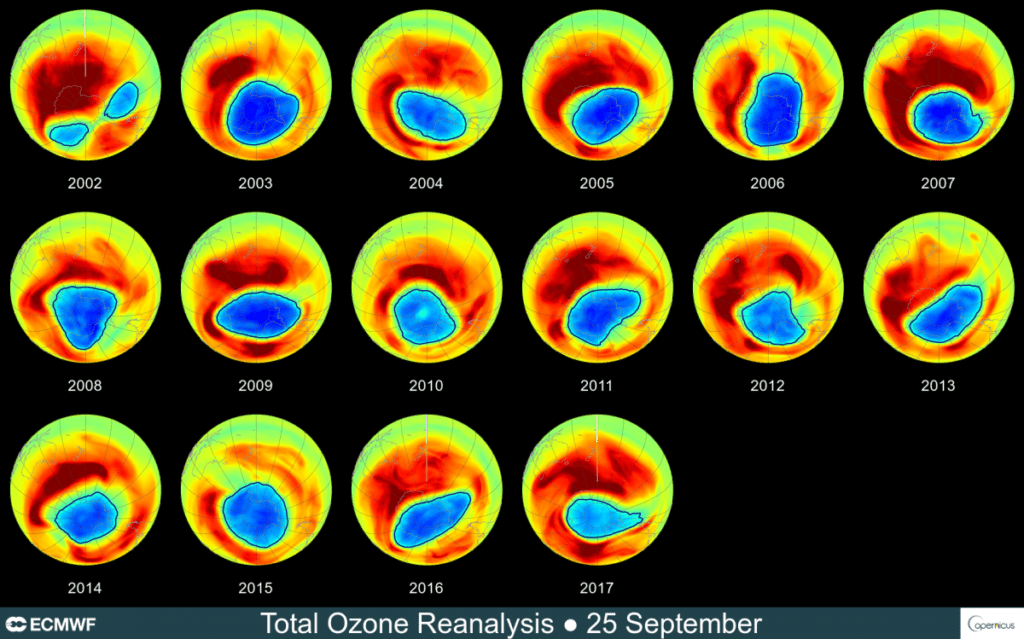After a string of depressing news about the climate and the environment, there’s finally something to be happy about. According to a new United Nations report, the hole in the ozone layer should completely heal within our lifetimes — a testament to the fact that concentrated international action really does work.

At ground level, ozone or smog is a poisonous chemical often expelled by vehicle exhaust. Higher up in the stratosphere, ozone accumulates at altitudes between 10 and 50 km where it acts as a shield against the harmful ultraviolet rays, which can cause cancer. Ozone holes occur naturally from cooling, but man-made chemicals greatly accelerate their formation. Chlorine, in particular, is very harmful since these atoms are extremely reactive with ozone. Currently, the ozone hole above Antarctica is the size of North America, which sounds humongous. However, it’s the smallest it’s been since 1988, according to NASA.
Almost 30 years ago, a UN emergency panel banned the use of chlorofluorocarbons (CFCs) under the Montreal Protocol. Scientists had learned that these chlorine-containing chemicals triggered the formation of a gaping hole in the ozone layer right above Antartica. Since then, the ozone layer has clearly recovered, marking a great success — one of the few but highly commendable episodes where nearly all the world’s countries chose to set aside their differences and work for the common good of the planet and all life that call it home.
In January 2018, researchers at NASA reported the first direct evidence that the ozone hole is recovering. They studied microwaves emissions that can identify and count trace gases even during the dark southern winter. According to the NASA researchers’ results, the ban on CFCs has resulted in about 20 percent less ozone depletion during the Antarctic winter compared to 2005. On average, chlorine levels are declining by about 0.8 percent annually, the authors reported in the Geophysical Research Letters.

Now, the latest report put out by a UN panel suggests that the ozone hole could patch up in the 2060s, if all goes to plan. The report has been released every four years since the Montreal Protocol was instated.
Some regions are recovering faster than others. Above the Arctic and mid-latitudes of the northern hemisphere, the ozone layer could return to normal levels by 2030s, while mid-latitudes in the southern hemisphere could reach pre-ozone depletion levels by mid-century.
“The Montreal Protocol is one of the most successful multilateral agreements in history for a reason,” said Erik Solheim, head of UN Environment.
“The careful mix of authoritative science and collaborative action that has defined the Protocol for more than 30 years and was set to heal our ozone layer is precisely why the Kigali Amendment holds such promise for climate action in future.”
The challenge will lie in keeping up this momentum. Though CFCs have been banned, there are other chemicals that contribute to the Antarctic ozone hole. Ironically, one chemical called dichloromethane, which has been officially deemed as a replacement for CFCs following the Montreal Protocol, can deplete the stratospheric shield. These chemicals usually break down in less than six months, but simulations show that dichloromethane and other so-called ‘very short-lived substances’ (VSLS) account for a significant portion of ozone loss in the stratosphere.
Over the past decade, dichloromethane became approximately 60% more abundant in the atmosphere as compared to the early 2000s. Besides dichloromethane, another highly concentrated chemical identified in the stratosphere includes 1,2-dichloroethane — an ozone-depleting substance used to make PVC, a popular construction material. PVC manufacturing has surged in the last couple of years in China, its main hotspot. There are also some places where the CFC ban is not enforced (again, China).
Another powerful class of ozone-depleting chemicals called hydrofluorocarbons (HFCs) is also worrisome. However, in response to the rapid growth of HFC emissions, the 197 parties to the Montreal Protocol adopted the Kigali Amendment in 2016 to reduce gradually their global production and consumption. HFCs, used mainly in refrigeration, air conditioning, and heat pump equipment, are thousands of times more harmful to the climate than CO2. Global implementation of the Kigali Amendment, which should enter into force on 1 January 2019, would prevent up to 80 billion tonnes CO2 equivalent of emissions by 2050, or the equivalent of 0.4% of global warming, by the end of the century.
“These new assessment results highlight the importance of continued long-term monitoring of HFCs in the atmosphere as the Kigali Amendment begins to take hold,” said David Fahey, Co-Chair of the Montreal Protocol Scientific Assessment Panel and scientist at the NOAA Earth System Research Laboratory in the US.
“Carbon dioxide emissions remain by far the most important greenhouse gases which are driving global warming. But we can also help tackle climate change by reducing our commitment to other gases including HFCs. Every bit of warming matters,” said World Meteorological Organization Secretary-General Petteri Taalas.


